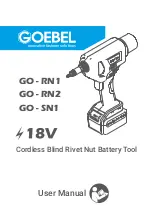
connection of the valve adapter to the valve when
using CTS (Copper Tube Size – flared or compres-
sion) adapters does not require pipe sealant but
must have the appropriate gasket in place and be in
good working condition.
3. Open, close and re-open the valve or the “corporation
stop”, this is to ensure that the pilot drill does not in-
terfere with the operation of the valve. In the event of
interference in closing the valve, another valve must
be substituted and this whole procedure must be
re-started.
Figure 11 – Attaching tool to valve
4. If the bleed off valve is to be used, a hose may be
connected to it to help direct the discharge.
Remember to restrain the free end of the hose to
control the direction of the discharge. Note that this
discharge is the same as the media in the pipe.
WARNING!
Be sure no one is standing in line of the discharge
from the bleed valve in the event of accidental
opening of the valve. Pressures may be very high
and can result in serious injury.
5. Turn the sleeve clockwise until the cutter comes into
light contact with the main, and back the sleeve up
one turn. Using the ratchet wrench, or a power
tool, rotate the drive shaft at the 11/16
″
hex while
continually applying pressure by turning the sleeve.
Do not apply too much pressure on the cutter and
pipe with the feed screw. Gentle light pressure ap-
plied with the feed will produce superior cutting
characteristics (Figure 12).
l) Calculate the ideal distance to penetrate in order to
stop at the centerline of the pipe. Add the valve
standoff distance from step (j) to the maximum stroke
from step (k) and divide the result by 2. (In the ex-
ample illustrated this is 10
1
/
2
″
plus 4
1
/
2
″
which gives
15
″
, then divided by 2 yields 7
1
/
2
″
ideal penetration.
m) Subtract the ideal penetration distance from the full
stroke in step (g). (In the example illustrated this is 14
″
total stroke minus 7
1
/
2
″
required stroke which equals
6
1
/
2
″
remaining unusable stroke.)
WARNING
Improper measurements may result in tapping
through bottom of pipe.
Figure 10 – Measuring maximum stroke
Tapping into the Main
1. If the bleed valve assembly is not going to be used,
ensure that the bleed-off valve is closed or a 3/8
″
plug
is installed. Use pipe sealant to seal the threads on
the bleed valve and plug.
2. Attach the fully assembled and fully extended tapping
tool to the outlet thread of the valve by screwing on
the valve adapter(Figure 11). Pipe sealant is required
for NPT and BSPT valve adapters in the temporary
assembly between the valve and the valve adapter
and it should be firmly tightened so as not to leak. The
RT3422 Tapping Tool
Ridge Tool Company
9
































